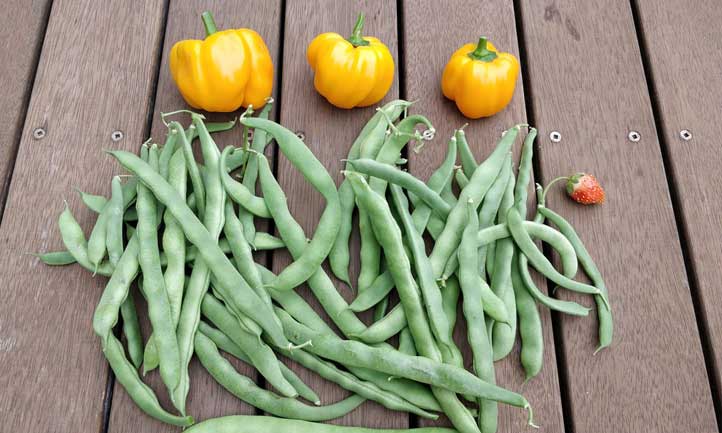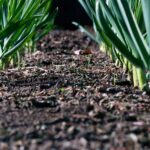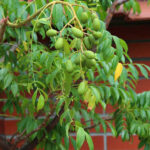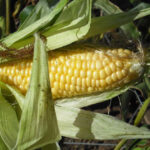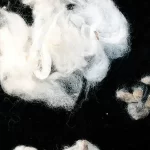Learning how to grow beans and having a hard time deciding whether to stay close to the ground with bush beans or go vertical with a pole bean variety? Pole beans have growth characteristics that provide space-saving beauty and visual interest in home gardens. Vining varieties, runner beans, and snap beans make going vertical an exciting element in any garden.
Common beans are divided into two main groups: pole and bush beans. Bush varieties form 8-20 inch bushes, whereas pole varieties form 7-10 foot vines.
Deftly named, these climbing beans require physical support. With so many pole bean trellis options, they’re an excellent choice for gardeners with limited or unique spaces. Vertical vines can produce 2 to 3 times more than bush beans in the same amount of space!
Pole beans are more than just showy foliage with beautiful flowers, delicious pods, and plump beans. They are high in vitamins A, C, and K, folic acid, and fiber, and growing them is easy to do just about anywhere.
Quick Care Guide

| Common Name | Pole bean, climbing bean |
| Scientific Name | Phaseolus vulgaris |
| Germination Time | 8-10 days if the soil is 70-80° Fahrenheit, longer if soil is below 60°F |
| Days to Harvest | 60-75 days |
| Light | Full sun |
| Water | Prefers consistent moisture, about 1 inch per week |
| Temperature | 70-85° Fahrenheit daytime temp |
| Humidity | Excess humidity and moisture can spur fungal diseases and bacterial growth |
| Soil | Well-drained soil |
| Fertilizer | Low nitrogen, example: 5-10-10 |
| Pests | Mexican bean beetles, aphids, leafhoppers, two-spotted spider mites |
| Diseases | Bacterial blights, bean common mosaic virus, white mold |
Recommended Pole Bean
Varieties
The main categories of beans include dry beans
(seeds harvested at full maturity when dry), snap beans (tender pods that snap
at harvest time, before their seeds develop), and shell or shelled beans
(tender seeds harvested at maturity).
Pole Beans
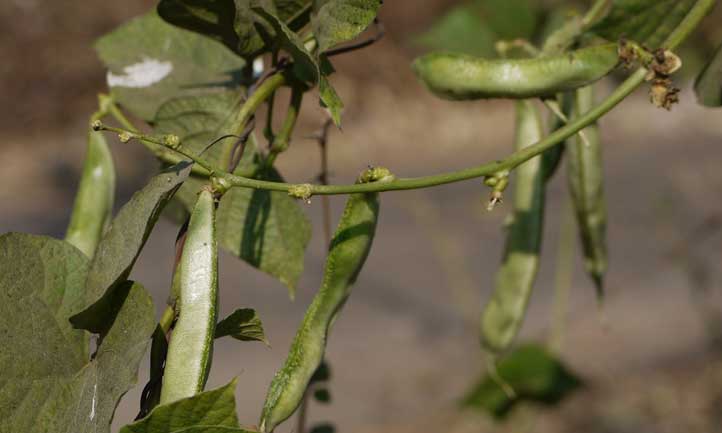
Both pole and bush beans are part of the same family, and the main difference is the support they need. In order to be successful, pole beans need trellises to guide the vines upward. Dozens of gorgeous varieties are available – broad, flat, straight, curved, lavender-pink, variegated striped, fresh-eating, dry-preserving – the list goes on.
| Variety | Growing Time | Description | Where to Buy |
| Kentucky Wonder | 65 days | Heirloom, brown seeded bean; pods can be eaten fresh or dried for shell beans | Buy Seeds |
| Blue Lake | 60 days | 6″ dark green pods with white seeds | Buy Seeds |
| Blauhilde | 65 days | 10″ purple pods form from rose-purple flowers | Buy Seeds |
| Musica | 67 days | 8″flat, bright green pods with white seeds; eaten fresh | Buy Seeds |
| Speckled Calico | 84 days | Cream colored beans with irregular red stripes; use fresh or dry | Buy Seeds |
| Gold Nectar | 70 days | 9″semi-flat, straight yellow pods | Buy Seeds |
Runner and Half Runner Beans
Although runner beans (Phaseolus coccineus) are a different breed from pole beans (Phaseolus vulgaris) they are both excellent climbers. I imagine runner beans “running” up toward the top of a trellis!
Half runner beans are snap beans (Phaseolus vulgaris) and, as the name implies, half-runners have the combined growing habits of bush and pole beans. Instead of growing 7-10 feet high, half-runners grow about 5 feet tall, making trellising, vine maintenance, and harvesting a little easier.
| Variety | Growing Time | Description | Where to Buy |
| Scarlet Runner | 65 days | Scarlet blossoms produce black and mauve speckled seeds; mostly used as shell beans | Buy Seeds |
| Painted Lady Improved | 68 days | Red and pink bi-colored blossoms produce black and tan speckled seeds; mostly used dry | Buy Seeds |
| Hidatsa Red Indian Half-runner | 85 days | Rose-red beans for dry use | Buy Seeds |
| Mountaineer White Half-runner | 57 days | Slender green pods with white seeds; eaten fresh | Buy Seeds |
Planting Pole Beans

How to grow pole beans? The large size of pole bean seeds makes planting easy and thinning sprouts isn’t necessary. They’re a great garden space maximizer and there are just a few rules to follow when planning and planting.
When to Plant
Pole bean seeds are somewhat sensitive to
colder temperatures so it is best to wait to plant until soil temperatures
reach at least 60 degrees Fahrenheit. Cooler soil temperatures just mean that
germination will take longer but it isn’t harmful to plant in cool soil. At an
ideal 70-80 degree soil temperature, germination will take about 8-10 days.
All bean seeds should be directly sown in the garden, as they do not tolerate transplanting well. Most pole bean varieties will be ready for their first harvest between 60 and 70 days after planting. After the first pick, be ready for multiple harvests throughout the season!
Where to Plant
Because they’re such amazing growers and require tall trellising, it is important to situate your trellis where it will not shade nearby plants that need full sun. A good rule of thumb is to plant trellises and tall growing plants near the north side of the garden. It is also best to install your trellis before seeding in order to avoid damaging the plant roots later.
How to Plant
Planting methods depend on the type of trellis that you choose for your space. If using a teepee or single-pole support, plant seeds 1 inch deep in mounded soil with 4 to 6 seeds at the base of each pole. If you are instead using a flat, more linear trellis, plant seeds 1 inch deep and 3 inches apart in a row along the bottom of the trellis.
If planting in rows, sow the seeds 6 inches apart in rows that are 24 to 36 inches apart.
Care
As long as your beans have the support of a sturdy trellis, there is very little to do until harvest time. Pole bean flowers bloom in a variety of colors and their prolific blossoms are breathtaking.
Sun
They will grow in partial shade but you will likely experience a smaller yield. Full sun is ideal for healthy plants and higher productivity.
Temperature
They prefer temperatures that are at least 60° Fahrenheit.
How Often to Water Pole Beans
Being shallow-rooted, they require at least 1 inch of water per week. Providing plants with consistent moisture is key, especially during flowering and fruiting. Beans in general are sensitive to moisture and can be prone to blights and molds, so it is important to avoid soaking the leaves when watering.
Soil
They prefer well-drained soil with a pH of 6.0 to 6.8. Mulching the plants with a fine mulch like compost or shredded leaves will help retain soil moisture and inhibit weed growth.
Fertilizing
Beans are classified as “light feeders,” which
means that fertilizing at planting time should be sufficient for your plants’
nutritional needs. Aged manure is an excellent fertilizer to incorporate into
the soil before planting. Spread the manure across the planting area at a depth
of about 3 inches and work it into the soil. Once the plants grow to about 4
inches tall, side-dress the plants with more aged manure.
Beans are also nitrogen fixers, which means that they absorb nitrogen from the air and release it into the soil. Because of this, it is important to avoid treating your plants with commercial fertilizers that contain large ratios of nitrogen. If you are using a prepared fertilizer, look for one that has a low nitrogen to phosphorus and potassium ratio like 5-10-10. Applying nitrogen fertilizer and combining that with the nitrogen fixed by beans will cause too much leaf and stem growth and may prevent bean growth and production.
Trellising Pole Beans
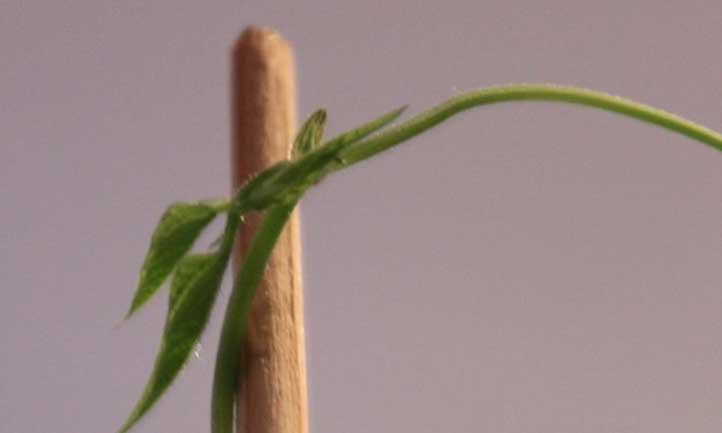
Pole beans need strong support
and there are lots of trellising
options out there for managing your vines. Many
garden centers sell pre-made trellises, but creating your own out of recycled
odds and ends can be really fun.
Some ideas for trellis
materials include:
- Bamboo canes
- Branches and sticks from trees
- Wire fencing
- Steel rebar
- Netting
- String
- Wire
From these materials, you can build arches,
walls, fences, or round structures with multiple legs for the climbing vines.
You could also use existing structures like tall fences and poles for a
cost-saving and beautifying addition to your space.
The vines will climb and wind their way around any structure, so don’t worry about needing to train them upward.
More natural options include using growing corn stalks or giant sunflowers as supports. Corn and squash are the traditional “sisters” to beans and all three can be grown together. Plant a few bean seeds at the base of a corn plant when it is about a foot high, and the cornstalk will support the bean vines while the squash shades the ground and keeps weeds at bay.
Harvesting and Storing
Harvesting Pole Beans
Harvest times depend on whether you plan to
eat the shelled beans or snap bean pods fresh, or will preserve the beans for
dry use.
For snap beans, harvest the pods when they are
young and before seeds begin to bulge inside the pods. Wait a little longer for
fresh shell beans; harvest them when the pods begin to dry but the seeds are
still plump and glossy. For dry beans, wait to harvest until the leaves have
turned brown or fallen to the ground. Do a test bite on a couple of the seeds,
if they barely dent, they are ready. The pods should be completely dry.
Storing Pole Beans
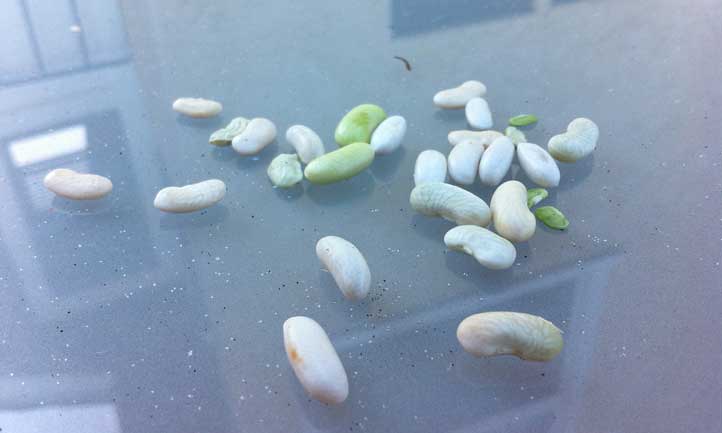
Fresh shelled or snap beans can be blanched
and frozen, canned, or pickled to preserve them for winter eating. Completely
dried beans should be stored away from heat and light in sealed containers like
mason jars.
Troubleshooting
Pole beans can be hit by diseases caused by
bacterium, fungi, or viruses and several common pests can also ruin your
harvest.
Below are some common pole bean pests and
diseases. For more in-depth coverage, check out the Troubleshooting section of How to Grow Beans: The Ultimate Guide.
Pests
As soon as warm weather arrives, Mexican bean beetles emerge from their winter slumber to feed on bean plants. Larvae and adult beetles snack on the leaves, leaving them looking lacey and skeletonized. Handpicking can control them, but if you have a serious infestation, you may need to use a neem oil spray or sprinkle plants with diatomaceous earth.
Aphids and spider mites pierce individual plant cells and feed on plant juices. To identify damage by these pests, look for curling, yellowing, or misshapen leaves. The undersides of leaves and plant stems are particularly appealing to aphids and spider mites. Neem is effective for controlling these pests. For a preventive option, try interplanting sweet alyssum with your beans. Sweet alyssum flowers attract aphid-loving predators!
Leafhoppers also feed by puncturing bean leaves and sucking out plant juices. A neem oil spray or sprinkling plants with diatomaceous earth will keep these pests in check.
Diseases
Bacterial blights can develop when leaf surfaces are constantly wet or damp. Encourage airflow around your plants by reducing overcrowding. Water close to the ground and avoid spraying the foliage.
Bean common mosaic virus is identified by discolored leaves in mosaic patterns of light and/or
dark green. This virus is spread by aphids and leafhoppers. Sadly, once your
bean plants are infected, there is no treatment available. Inspect your bean
leaves regularly and treat for aphids and leafhoppers as soon as possible.
White mold is caused by a fungus and looks like typical white, fluffy mold. Cool, wet weather encourages this disease. Commercial fungicides could be used but there aren’t many organic options. For prevention, encourage airflow among your plants to reduce moisture on the leaves and the soil surface.
Frequently Asked Questions
Q. What are the best pole beans to grow?
A. Some of the most popular pole beans include
Blue Lake, Kentucky Blue, and Scarlet Runner.
Q. How do you start pole bean seeds?
A. They don’t like being started inside and then transplanted to the garden. Direct sow beans in the garden when the soil has warmed to at least 60 degrees Fahrenheit.
Q. In what temperature do pole beans grow best?
A. Pole bean germination takes approximately
8-10 days when the soil temperature is adequately warm. Ideal soil temperature
is 70-80 degrees Fahrenheit. Pole beans grow best when the daytime air
temperature is at least 60 degrees Fahrenheit.
Q. How long does it take for pole beans to produce?
A. Most pole beans mature in 65-75 days.
Pole beans are a beautiful and space-maximizing addition to any home garden. With all of the varieties out there, it’s difficult to choose just one or two to try! What are your favorite varieties? Share your growing experience in the comments below!

